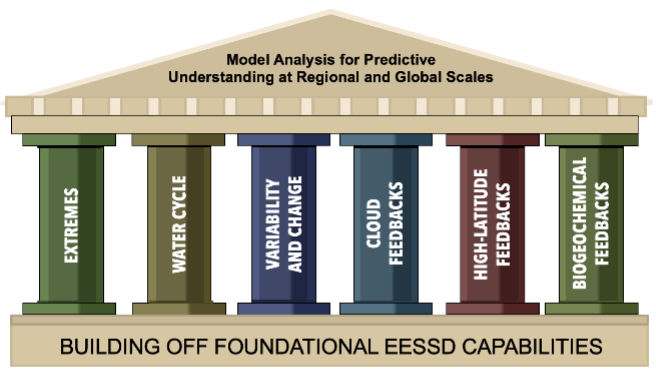About Regional & Global Model Analysis
The goal of the Regional & Global Model Analysis (RGMA) area is to enhance predictive-, process-, and system-level understanding of modes of variability and change within the earth system while using E3SM along with a suite of regional and global earth system models (ESMs), innovative data architectures, uncertainty characterization, and diagnostics measures. This area advances capabilities to design, evaluate, diagnose, and analyze hierarchical global and regional earth system models and simulations informed by observations, while focusing on predictability across a wide range of temporal and spatial scales. Topics, oriented around broad and robust simulation campaigns, include such scientifically and societally challenging issues as extreme events and tipping points, water and biogeochemical cycles, high-latitude and mid-latitude interactions, cloud and aerosol feedbacks, and earth system model benchmarking from global to local scales.

The rapidly increasing complexity of ESMs necessitates a rigorous and comprehensive understanding and evaluation of their skill and behavior. Multifaceted, multisystem approaches are required to probe and understand the various feedbacks within and among individual components within the Earth system, including the atmosphere, ocean, land surface, and cryosphere. The use of model simulations, in combination with observations, enables a deeper understanding of the earth system and models that emulate it.
The RGMA area focuses on analyzing regions critical to understanding earth system variability and change; evaluating robust methods for higher spatial resolution simulations; and diagnosing and analyzing state-of-the-science ESMs across a wide range of scales. These analyses often take the form of modeling experiments that target various aspects of the earth system, including analysis of system response to perturbations, exploration of predictability on subseasonal to decadal scales, and analysis of feedbacks within the earth system. Understanding and reducing biases in ESMs as well as uncertainty characterization are also important elements of the RGMA program area.
To enhance understanding of processes and feedbacks, and to reduce uncertainties and biases in ESMs, the RGMA program area has six major thrusts, each with unique priorities. These are enabled through a combination of grants and cooperative agreements (CAs) at universities and Science Focus Areas (SFA) that serve as major projects at national laboratories:
- Cloud Processes and Feedbacks focuses on improving simulation accuracy through better cloud representations in ESMs and on determining the cloud feedbacks that influence, e.g., the capacity of the Earth’s atmosphere to facilitate radiative dis-equilibrium.
- Biogeochemical Processes and Feedbacks focuses on identifying and quantifying feedbacks between biogeochemical cycles and the Earth system and on quantifying and reducing the uncertainties in ESMs associated with these feedback processes.
- High-Latitude Processes and Feedbacks aims at a better understanding of the processes driving rapid system change at high latitudes and the subsequent effects on the Earth’s environment.
- Modes of Variability and Change provides insight on the interplay between internally generated variability and externally forced response for improved understanding of near-term decadal predictability and projections in the context of longer-term projections.
- Extreme Event Drivers, Statistics, and Uncertainties targets actionable understanding of multi-sectoral impacts of extreme weather events, especially droughts, floods, and tropical cyclones, and the physical mechanisms that drive variability and change in extremes.
- Water Cycle focuses on advancing the understanding of multiscale water cycle processes and hydrologic extremes and their response to perturbations in the context of the whole Earth system and implications for water availability.
Some of the cross-cutting capabilities that are the strength of the RGMA investments that contribute to the Dynamical Digital Testbeds and the extensive EESM framework include:
- Development of frameworks using a hierarchy of models, ranging from the most complex, hyper- and high-resolution ESMs, such as the Department of Energy’s Energy Exascale Earth System Model (E3SM), non-hydrostatic atmospheric models, variable resolution models, and super parameterized models to less complex system models or idealized configurations of complex models for hypothesis testing and addressing scientific questions.
- Holistic uncertainty characterization is enabled by a suite of tools, ranging from cutting-edge computational capabilities to complementary empirical models enabled by the latest statistical techniques. This enables us to understand and evaluate the need for improved observations and models.
- Diagnosing the complex behavior of model simulations and evaluating the capability of models through systematic comparison with available observations and quantifiable metrics, novel diagnostics, and robust extreme event identification methods are some of the core activities of the RGMA program area. These provide pathways for advancing an understanding of the Earth system, improving models, and reducing uncertainties that exist in current ESMs.
- Developing new processing, analysis, and model evaluation paradigms that facilitate comprehensive and holistic evaluation of Earth system models and datasets, so as to identify persistent biases and improve data credibility. Creation of efficient workflows to enable the analysis of petascale data and unstructured grid output produced by exascale models.
Solicitations: Funding opportunity announcements are posted on the DOE Office of Science Grants and Contracts Website and at grants.gov. Information about preparing and submitting applications, as well as the DOE Office of Science merit review process, is at the DOE Office of Science Grants and Contracts Website.
Data Sharing Policy: Funding for projects by the program area is contingent on adherence to the BER data sharing policy.
